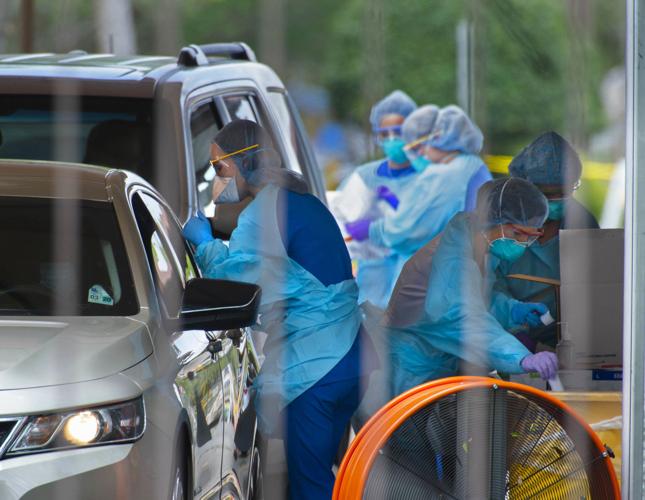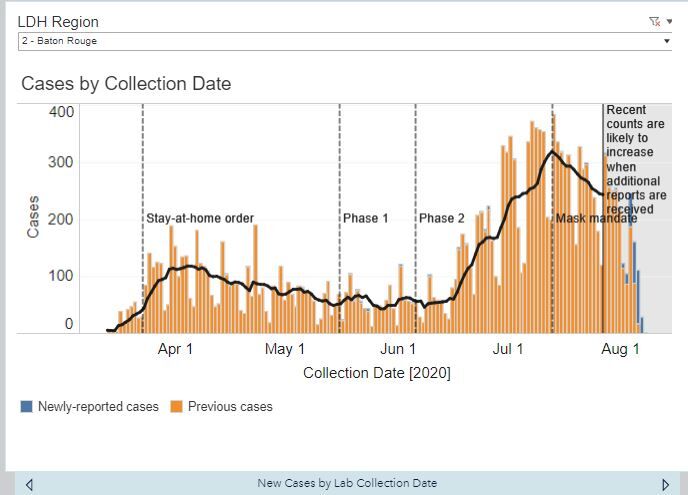Since a statewide mandatory mask order and the re-closure of bars took effect July 13, the seven-day average for new coronavirus cases has been trending sharply downward in the 12-parish Baton Rouge area.
The state health region that incorporates most of the Baton Rouge area has seen its rolling average fall by nearly 24% in the two weeks since the mask order and bar closures took effect, state data show.
And, in each of the three multi-parish health regions in the capital area, July 13 or July 14 was the all-time peak for average cases since the outbreak emerged in early March, the data show.
While state officials and some health experts say masks and other mitigation measures are certain to help if people follow them -- and that cases may be plateauing -- they also offered cautious assessments about what the state's data are showing at this point.
They said it may be too soon yet to say those trends lines definitively show that Gov. John Bel Edwards' mask order and the bar closures were causing the declining rate of new cases in the capital region.
"It's correlated, it appears, in time and temporally, but cause? We need a little bit more time before we can say that 'Great, the mask mandate seems to be working,'" said Susan Hassig, a Tulane University epidemiologist.
Unlike the raw case data the state reveals six days per week, which can incorporate positive cases from days to weeks ago, the Department of Health dashboard graphic displays a seven-day average for new cases by the date that the tests were collected.
This data may come closer to revealing the state of infection on a given date -- as much as any testing can reveal -- but the state graphic also currently has a nearly two-week lag as testing information is tabulated.
Health Region 2 comprises much of the core of the capital area. It includes Ascension, East Baton Rouge, East Feliciana, Iberville, Pointe Coupee, West Baton Rouge and West Feliciana parishes.
Between July 13 and 27, the seven-day average for new cases in Region 2 fell from 319 to 243.6, the state says.
In the five-parish North Shore health Region 9, which includes Livingston, St. Helena and Tangipahoa parishes, the seven-day average has fallen by nearly 25%.
Between July 13 and 27, the seven-day average for new cases in Region 9 fell from 229.6 to 173, the state says.
In Region 3, which includes St. James and Assumption parishes, the drop has been less significant -- 13.3%.
While the state health department also provides day-to-day counts for new cases since July 27, the agency says it is still collecting data for new cases after that date to formulate the seven-day rolling average.
A spokesman for the Department of Health said Friday that state officials viewed the numbers as "encouraging," but he was reluctant to ascribe the trend to any one thing at this point.
Dr. Gina Lagarde, regional medical director for state Office of Public Health in Region 9, told reporters in a news conference Thursday that, in her region, the state mitigation measures have had an impact on cutting down on new cases over the past two weeks.
But the virus remains wide-spread and new cases continue to be above federal per-capita benchmarks.
"The good news is that the mitigation efforts that have been put in place with mandates and some of our restrictions (are) showing that for all five of our parishes, the incidence of COVID(-19) is decreasing," Lagarde said.
Dr. Joshua L. Denson, a pulmonary critical care physician at Tulane Medical Center in New Orleans and a Tulane assistant professor, also was reluctant to link a cause and effect between the July 13 restrictions and the recent drop in cases just yet.
He noted that cases in East Baton Rouge Parish and the wider area remain high. But what is beyond doubt for Denson is that masks and other restriction do help reduce the transmission of the virus, both for the wearer and those nearby.
"Honestly, I wear masks in the hospital to protect me all the time and it works," said Denson, who has treated coronavirus patients through the pandemic and has not been infected.
Hassig, the Tulane epidemiologist, said it can be tricky to determine if the change in cases is truly reflecting a decline in infections at this point --perhaps due to mitigation and social distancing measures -- or if the number and type of people being tested has changed.
She noted the daily positivity rate in the Baton Rouge area Region 2, which hasn't been below the federal threshold of 10% since June 16, began to turn back up in mid-July after a sharp drop earlier in the month. The rate was nearly 14.7% through July 31.
Hassig said she'd like to see what effect the end of the federal surge testing sites in the Baton Rouge area last week will do to positivity, which reflects the share of positive cases per test, and to new case numbers.
"These are not perfect measures, and so when you look at one, you always have to kind of think about, what are the alternate explanations," she said.








